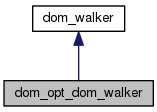

Public Member Functions | |
| dom_opt_dom_walker (cdi_direction direction) | |
| virtual void | before_dom_children (basic_block) |
| virtual void | after_dom_children (basic_block) |
| void | walk (basic_block) |
Private Member Functions | |
| void | thread_across_edge (edge) |
Private Attributes | |
| gimple | m_dummy_cond |
Constructor & Destructor Documentation
|
inline |
Member Function Documentation
|
virtual |
We have finished processing the dominator children of BB, perform any finalization actions in preparation for leaving this node in the dominator tree.
If we have an outgoing edge to a block with multiple incoming and outgoing edges, then we may be able to thread the edge, i.e., we may be able to statically determine which of the outgoing edges will be traversed when the incoming edge from BB is traversed.
Only try to thread the edge if it reaches a target block with
more than one predecessor and more than one successor. Similarly for the ELSE arm.
These remove expressions local to BB from the tables.
Reimplemented from dom_walker.
References dump_file, dump_flags, print_generic_expr(), and print_gimple_expr().
|
virtual |
Function to call before the recursive walk of the dominator children.
Push a marker on the stacks of local information so that we know how far to unwind when we finalize this block.
PHI nodes can create equivalences too.
Create equivalences from redundant PHIs. PHIs are only truly redundant when they exist in the same block, so push another marker and unwind right afterwards.
Now prepare to process dominated blocks.
Reimplemented from dom_walker.
|
private |
Wrapper for common code to attempt to thread an edge. For example, it handles lazily building the dummy condition and the bookkeeping when jump threading is successful.
Push a marker on both stacks so we can unwind the tables back to their current state.
Traversing E may result in equivalences we can utilize.
With all the edge equivalences in the tables, go ahead and attempt to thread through E->dest.
And restore the various tables to their state before we threaded this edge. XXX The code in tree-ssa-threadedge.c will restore the state of the const_and_copies table. We we just have to restore the expression table.
Referenced by restore_vars_to_original_value().
|
inherited |
Walk the dominator tree.
Recursively walk the dominator tree. BB is the basic block we are currently visiting.
Don't worry about unreachable blocks.
Callback for subclasses to do custom things before we have walked
the dominator children, but before we walk statements. Mark the current BB to be popped out of the recursion stack
once children are processed. NULL is used to mark pop operations in the recursion stack.
Callback allowing subclasses to do custom things after we have
walked dominator children, but before we walk statements.
References bb_postorder, inverted_post_order_compute(), last_basic_block, n_basic_blocks, and postorder_num.
Field Documentation
|
private |
Referenced by restore_vars_to_original_value().
The documentation for this class was generated from the following file:
